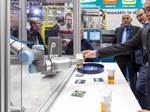New Robots Made Safer Around People—Without Sacrificing Performance
One robot, five levels of safety around people.
So-called “collaborative” robots, or “cobots,” have captured the imagination of a number of plastics processors who are looking for automation that can operate safely in close proximity to human workers and doesn’t have to be locked away behind “hard” guarding. However, these cobots are often compared unfavorably with standard robots in terms of significantly lower speed and payload capacity. That’s why there’s a trend afoot to make conventional robots collaborative—i.e., safe around people—without sacrificing high speed and load-carrying capacity (see it here). One supplier that recently showed off this capability at April’s Automate show in Chicago is Staubli Corporation, Duncan. S.C. At the show, Staubli showed off its new TX2 six-axis articulated robots (which also were featured at K 2016 in Dusseldorf). Sebastien Schmitt, Robotics Div. Manager, explains the significance of this new robot series in terms of five levels of Man-Robot Collaboration (MRC):
• MRC-1 is the standard robot setup, inside a cage so that it can operate at high speed with no possibility of contacting a human.
• MRC-2 (human contact not desired but possible) and MRC-3 (human contact expected) eliminate guarding but use electronic sensors such as laser scanners to sense when a human approaches. Two safety zones are defined: If a human enters one zone of proximity, the robot slows to a relatively safe speed, so the human can easily avoid it. If a human enters an even closer zone of proximity, the robot comes to a complete stop. What’s unique about this setup is that as soon as the human moves away from the robot, it immediately resumes slow motion on its programmed path, and then full speed as the person moves farther away. No reset command is required.
• MRC-4 is force-limited operation of the robot, so that it can run fast but stop immediately upon contact without harming the human—or itself if it strikes a hard obstacle, like a forklift. This functionality can be enhanced by covering the robot with a touch-sensitive skin to help it stop on contact.
• MRC-5 is the highest level of collaboration, in which a human manually guides the robot arm to achieve precise positioning of the end-of-arm tooling—perhaps in a hard-to-reach area and/or when the object being handled is heavy or cumbersome. The robot thereby acts as an extension of, or assistant to, the human, but with no limitation in payload capacity.
Schmitt says that the innovation in Staubli’s TX2 series robots (photo) is that they can be programmed to operate in all five MRC levels. Schmitt called the TX2 “the world’s fastest safe robot.” He noted that these robots come with a new CS9 safety control and have a “separate safe digital encoder” for each axis and an “integrated safety board.” The series has six models that handle loads from 2 to 15 kg with a reach of 515 to 1450 mm. To ensure maximum safety, every motion is monitored by sensors and all position coordinates of the robot arm, as well as its speed and acceleration, are recorded in real time.
Related Content
-
Scaling New Heights With Vertical Integration
Eden Manufacturing was founded on a vision of vertical integration, adding advanced injection molding capabilities to a base of precision moldmaking and more recently bringing Swiss-type machining capabilities in-house.
-
Five Ways to Increase Productivity for Injection Molders
Faster setups, automation tools and proper training and support can go a long way.
-
Drones and Injection Molding Ready for Takeoff
Drones and unmanned aerial vehicles (UAV) are approaching an inflection point where their production volumes — and functionality — will increasingly point to injection molding.














